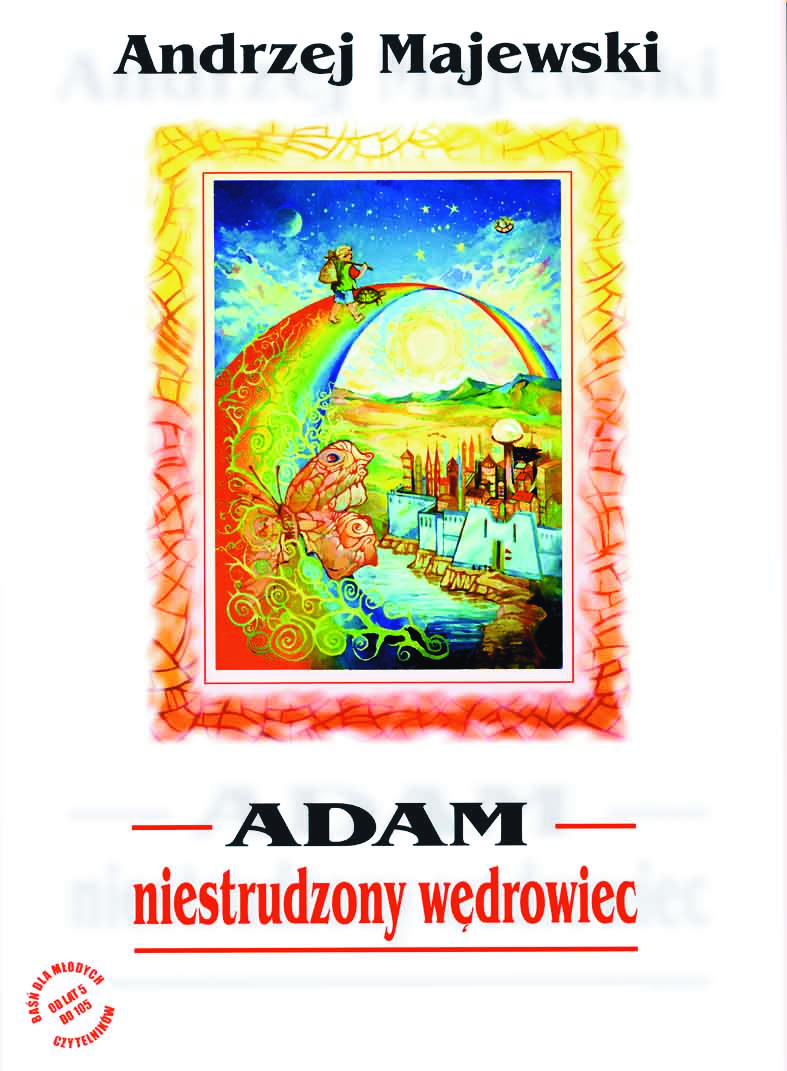Title of the work
Country of the First Edition
Country/countries of popularity
Original Language
First Edition Date
First Edition Details
Andrzej Majewski, Adam niestrudzony wędrowiec, ill. Marcin Giejson. Warszawa: Wydawnictwo Salezjańskie, 2002, 184 pp.
ISBN
Official Website
andrzejmajewski.com (accessed: July 5, 2021)
Available Onllne
andrzejmajewski.com (accessed: July 5, 2021)
docplayer.pl (accessed: July 5, 2021)
Genre
Narrative poetry
Target Audience
Children
Cover

Illustrations by Marcin Giejson. Courtesy of the author.
Author of the Entry:
Summary: Gabriela Rogowska, Univeristy of Warsaw, g.rogowska@al.uw.edu.pl
Analysis: Marta Pszczolińska, University of Warsaw, m.pszczolinska@al.uw.edu.pl
Peer-reviewer of the Entry:
Katarzyna Marciniak, University of Warsaw, kamar@al.uw.edu.pl
Elżbieta Olechowska, University of Warsaw, elzbieta.olechowska@gmail.com

Photograph courtesy of the Author.
Andrzej Majewski
, b. 1966
(Author)
Author of aphorisms, writer, commentator, photographer, scriptwriter, director. Graduated from the Wrocław University of Economics, LL.D. at the University of Wrocław. Famous for his aphorisms published in Polish as well as in international anthologies and translated into many languages (Czech, English, German, Greek, Hebrew, Italian, Korean, Romanian, Russian, and Turkish). He won many awards for his aphoristic works. Author of a fairytale Adam niestrudzony wędrowiec [Adam the Tireless Wanderer], 2002, and of a guide for children 102 rady dla dzieci mądrych, grzecznych i krnąbrnych [102 Bits of Advice For Wise, Good and Naughty Children], 2003 – both written in rhyming verses. His poems and stories for children appear in textbooks and children’s periodicals. Director and scriptwriter for a television series “Klub Radzika” [A Little Advisor’s Club] based on his book 102 rady dla dzieci mądrych, grzecznych i krnąbrnych; scriptwriter for an educational TV series Ekonomia na co dzień [Economics for Every Day Use], 2007, and Ekonomia w szkole [Economics at School], 2007.
Source:
Official website (accessed: July 5, 2021).
Bio prepared by Gabriela Rogowska, Univeristy of Warsaw, g.rogowska@al.uw.edu.pl
Summary
Based on: Katarzyna Marciniak, Elżbieta Olechowska, Joanna Kłos, Michał Kucharski (eds.), Polish Literature for Children & Young Adults Inspired by Classical Antiquity: A Catalogue, Faculty of “Artes Liberales”, Warsaw: University of Warsaw, 2013, 444 pp., section by Gabriela Rogowska, pp. 175–176.
The hero of the book is Adam – a little boy found by an old couple in the forest. When the boy grows a little older he sets out on a journey seeking the wisdom of the world and learning about good and evil. His odyssey leads him through numerous places and adventures. First, he finds himself in a forest where he learns from animals, then on the sea fighting with Hurricane and meeting the mermaids; next he goes up the rainbow but he cannot reach its end and falls down. Fortunately, he is rescued by a vulture who asks him a riddle. Adam gives the vulture the right answer and he is carried back to the rainbow. There he meets a tortoise named Janek who challenges him to a race. Sure of his victory, Adam takes a nap, while the tortoise wins the contest. For the rest of the journey, Adam and Janek travel together. They face a series of dangers: an evil wizard and demon-dogs. Adam comes into possession of two magic keys and he discovers his special mission – he must free the prisoners of the Lord of the World. Finally, Adam and Janek reach this empire. There Adam has the opportunity to save the Lord’s daughter. As a reward, Adam is offered a choice between becoming rich and becoming an apprentice to the wizard. The boy chooses the second option. By then he knows how to help the captives using magic keys. Finally, Adam and Janek with the help of the princess set the city free and leave.
Analysis
This book combines the light register of a narrative poem full of adventures with some educational and even philosophical content. The simple rhymes of the ten-syllable verse with a caesura make the reading accessible and easily memorized. While traveling and helping people and animals, the protagonists seek answers to questions about life and its secrets; good and evil, egoism and altruism, friendship and loyalty.
During his extraordinary journey, Adam meets many characters and situations. References to classical Antiquity are few, but there is a very important one for the action and its further development: the Aesopian race between a slow contestant and a fast one. Sirens provide a minor ancient presence, but while they are only mentioned (p. 37, verse 4), they still display their most recognizable attribute – singing. Chapter IV is entirely devoted to the ancient motif borrowed from Aesop’s fable Χελώνη καὶ λαγωός [The Tortoise and the Hare] (accessed: July 5, 2021); as a result, a new protagonist appears – Janek, the turtle. Adam travels magically along the rainbow and meets a friendly talking animal. The boy seeks a companion for his travels but refuses to take Janek because he considers him too slow. Then the tortoise proposes a race along the rainbow. The race proceeds exactly as told by Aesop – the protagonist takes a nap, and the tortoise slowly but consequently reaches the finish line first. Just like Aesop’s hare, Adam is defeated by the slower animal because of his conceit and dismissal of a slower adversary. Having won the race, the tortoise tells Adam that it is not his first victorious contest. He suggests an example from his past when a hare, who was so sure of winning, disregarded the turtle and eventually lost. Therefore, Aesop’s fable is evoked directly as an episode from Janek’s past. The basic difference between Aesop’s and Majewski’s version is what happens next. For Adam and Janek, the race becomes the beginning of a long and extraordinary friendship, in which both care for each other, show loyalty and are willing to make sacrifices. The friendship between the contestants is possible because the loser has not been mocked and humbly accepted the defeat as a life lesson.
The last element possibly referencing Antiquity is the character of Magus, somewhat resembling the Sphinx who terrorized Thebes. Magus, an evil wizard, challenges every passer-by with his unsolvable riddle; a hasty answer brings death to the hapless traveler – that is why there are plenty of human bones around. Nobody before Adam was able to survive the encounter because the riddle was a trap. Magus asks each traveler whether they judge him worthy to slay them: if they answer “yes”, he kills them, and if they answer “no”, he flies into a rage and kills them anyway. The clever boy uses his wit and reverses the question, answering that it is he who is not worthy to die from Magus’ hand (p. 69). Fortunately, the wizard is taken aback by this unexpected answer and spares Adam’s life.
All three references are designed to resonate with the young readers, who are certainly familiar with the sirens, Aesopian fables with their later imitations, and the concept of the riddle, all embedded in popular culture through a variety of literary and audiovisual texts. The riddle, in particular, cannot fail to bring to mind the beloved scenes from Tolkien’s The Hobbit and, more recently, from Rowling’s Harry Potter and the Goblet of Fire.
Further Reading
andrzejmajewski.com (accessed: July 5, 2021).


